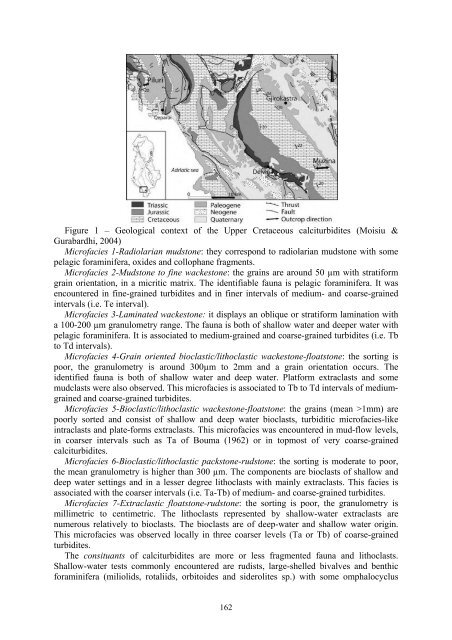DYNAMICS and ACTIVE PROCESSES - International Lithosphere ...
DYNAMICS and ACTIVE PROCESSES - International Lithosphere ...
DYNAMICS and ACTIVE PROCESSES - International Lithosphere ...
You also want an ePaper? Increase the reach of your titles
YUMPU automatically turns print PDFs into web optimized ePapers that Google loves.
Figure 1 – Geological context of the Upper Cretaceous calciturbidites (Moisiu &<br />
Gurabardhi, 2004)<br />
Microfacies 1-Radiolarian mudstone: they correspond to radiolarian mudstone with some<br />
pelagic foraminifera, oxides <strong>and</strong> collophane fragments.<br />
Microfacies 2-Mudstone to fine wackestone: the grains are around 50 µm with stratiform<br />
grain orientation, in a micritic matrix. The identifiable fauna is pelagic foraminifera. It was<br />
encountered in fine-grained turbidites <strong>and</strong> in finer intervals of medium- <strong>and</strong> coarse-grained<br />
intervals (i.e. Te interval).<br />
Microfacies 3-Laminated wackestone: it displays an oblique or stratiform lamination with<br />
a 100-200 µm granulometry range. The fauna is both of shallow water <strong>and</strong> deeper water with<br />
pelagic foraminifera. It is associated to medium-grained <strong>and</strong> coarse-grained turbidites (i.e. Tb<br />
to Td intervals).<br />
Microfacies 4-Grain oriented bioclastic/lithoclastic wackestone-floatstone: the sorting is<br />
poor, the granulometry is around 300µm to 2mm <strong>and</strong> a grain orientation occurs. The<br />
identified fauna is both of shallow water <strong>and</strong> deep water. Platform extraclasts <strong>and</strong> some<br />
mudclasts were also observed. This microfacies is associated to Tb to Td intervals of mediumgrained<br />
<strong>and</strong> coarse-grained turbidites.<br />
Microfacies 5-Bioclastic/lithoclastic wackestone-floatstone: the grains (mean >1mm) are<br />
poorly sorted <strong>and</strong> consist of shallow <strong>and</strong> deep water bioclasts, turbiditic microfacies-like<br />
intraclasts <strong>and</strong> plate-forms extraclasts. This microfacies was encountered in mud-flow levels,<br />
in coarser intervals such as Ta of Bouma (1962) or in topmost of very coarse-grained<br />
calciturbidites.<br />
Microfacies 6-Bioclastic/lithoclastic packstone-rudstone: the sorting is moderate to poor,<br />
the mean granulometry is higher than 300 µm. The components are bioclasts of shallow <strong>and</strong><br />
deep water settings <strong>and</strong> in a lesser degree lithoclasts with mainly extraclasts. This facies is<br />
associated with the coarser intervals (i.e. Ta-Tb) of medium- <strong>and</strong> coarse-grained turbidites.<br />
Microfacies 7-Extraclastic floatstone-rudstone: the sorting is poor, the granulometry is<br />
millimetric to centimetric. The lithoclasts represented by shallow-water extraclasts are<br />
numerous relatively to bioclasts. The bioclasts are of deep-water <strong>and</strong> shallow water origin.<br />
This microfacies was observed locally in three coarser levels (Ta or Tb) of coarse-grained<br />
turbidites.<br />
The consituants of calciturbidites are more or less fragmented fauna <strong>and</strong> lithoclasts.<br />
Shallow-water tests commonly encountered are rudists, large-shelled bivalves <strong>and</strong> benthic<br />
foraminifera (miliolids, rotaliids, orbitoides <strong>and</strong> siderolites sp.) with some omphalocyclus<br />
162




